Development of indie games by one person (history, tips)
I would like to tell you about my experience in developing an indie game. My experience is limited to just one game, which is currently in “early access” on Steam. This is not much, but I think I have something to share. If you do not want to read everything - in the end the most interesting is brief.

Since One of my favorite genres is TD (tower defense, tower defense) - I wanted to try to create something similar to a game of this genre. Before I started working with Unity (and accordingly with C #), I only worked with PHP and Python.
A bunch of Unity + C # seemed to me more successful (and simpler) than the Unreal Engine + C ++. To begin with, I met C # (I made a simple program in Visual Studio), and then I started learning Unity. If you already own a good level of one of the programming languages - C # will be simple and straightforward. Getting to know Unity is much more difficult.
')
Unfortunately, at the time of the beginning of the creation of the game I did not read more than one book on Unity. I started with several online courses and videos that fluently introduce Unity tools. I can call it one of the biggest mistakes. That is, I studied working with Unity directly working in Unity (creating the game). But in principle, this did not contradict what I wanted. At the very beginning I did not think that the game would turn out, and I would start selling it. I just wanted to get acquainted with the engine, maybe after that try the UE.
After watching a few videos, as well as an excellent video tutorial on creating TD in Unity, I started my own business. I had only a few hours a week to create a game. I watched the video, read the documentation, googled incomprehensible moments, did something. The game began to turn from “circles shooting squares” into “a man with an ax beats a wolf”. I slowly mastered the simplest tools of Unity and interaction with C #. Unfortunately, the very first versions of the game, or screenshots, have not been preserved (those that are, this is about 2-3 months from the start of creation).

According to my estimations, that small squares began to run on the map, and circles would be shooting at them — it took about two weeks. On the fact that to replace the squares on the enemies, and the circles on the defenders and also the levels on something similar to TD - a few more weeks.
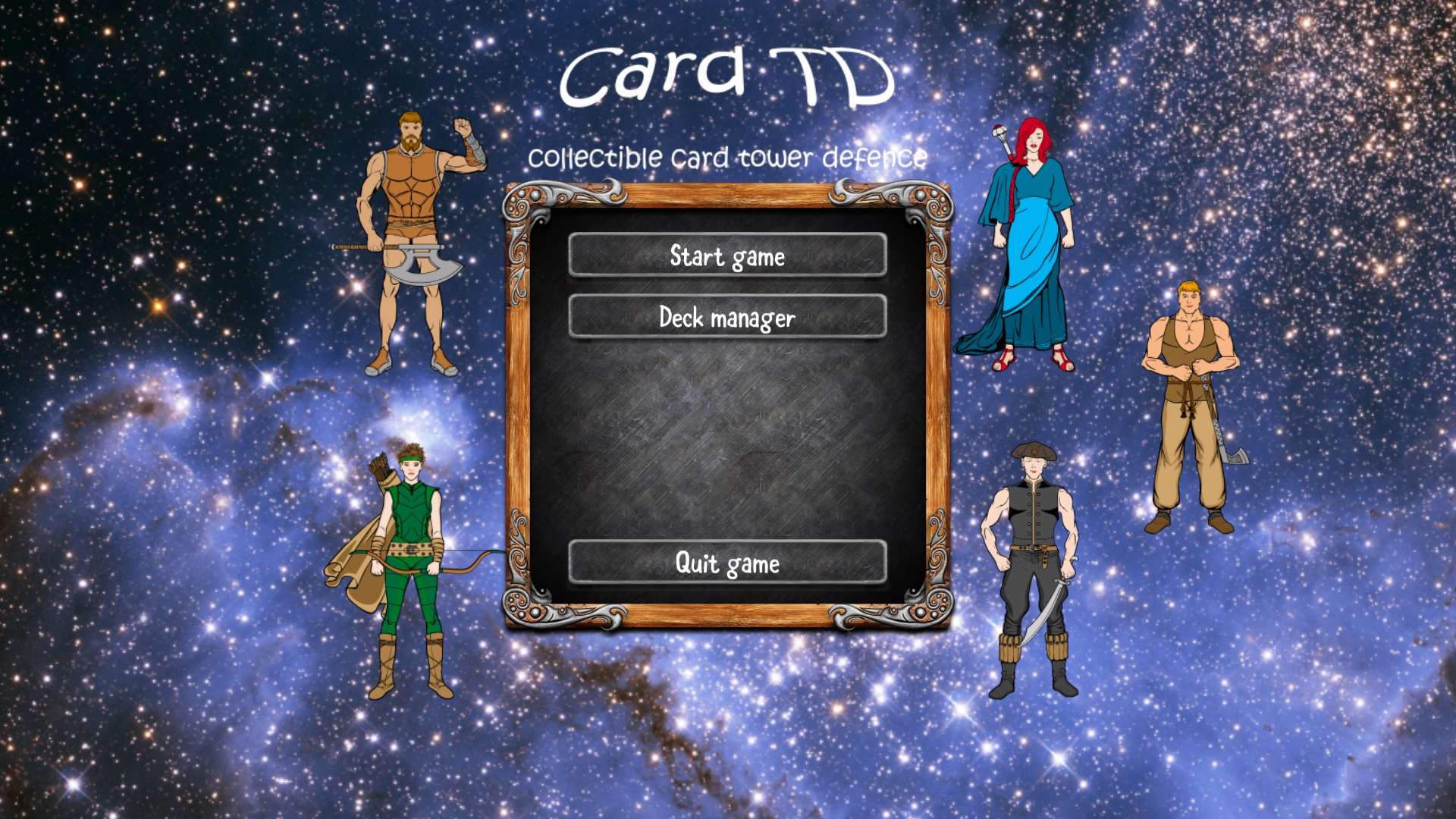
I also made the simplest menu, and something like a deck manager, because I have a TD with elements of CCG (collectible card games) and RPG. Then work began on the RPG component, it was interesting for me to come up with formulas for calculating damage, armor, accuracy, crit, etc. and add to all this CCG.
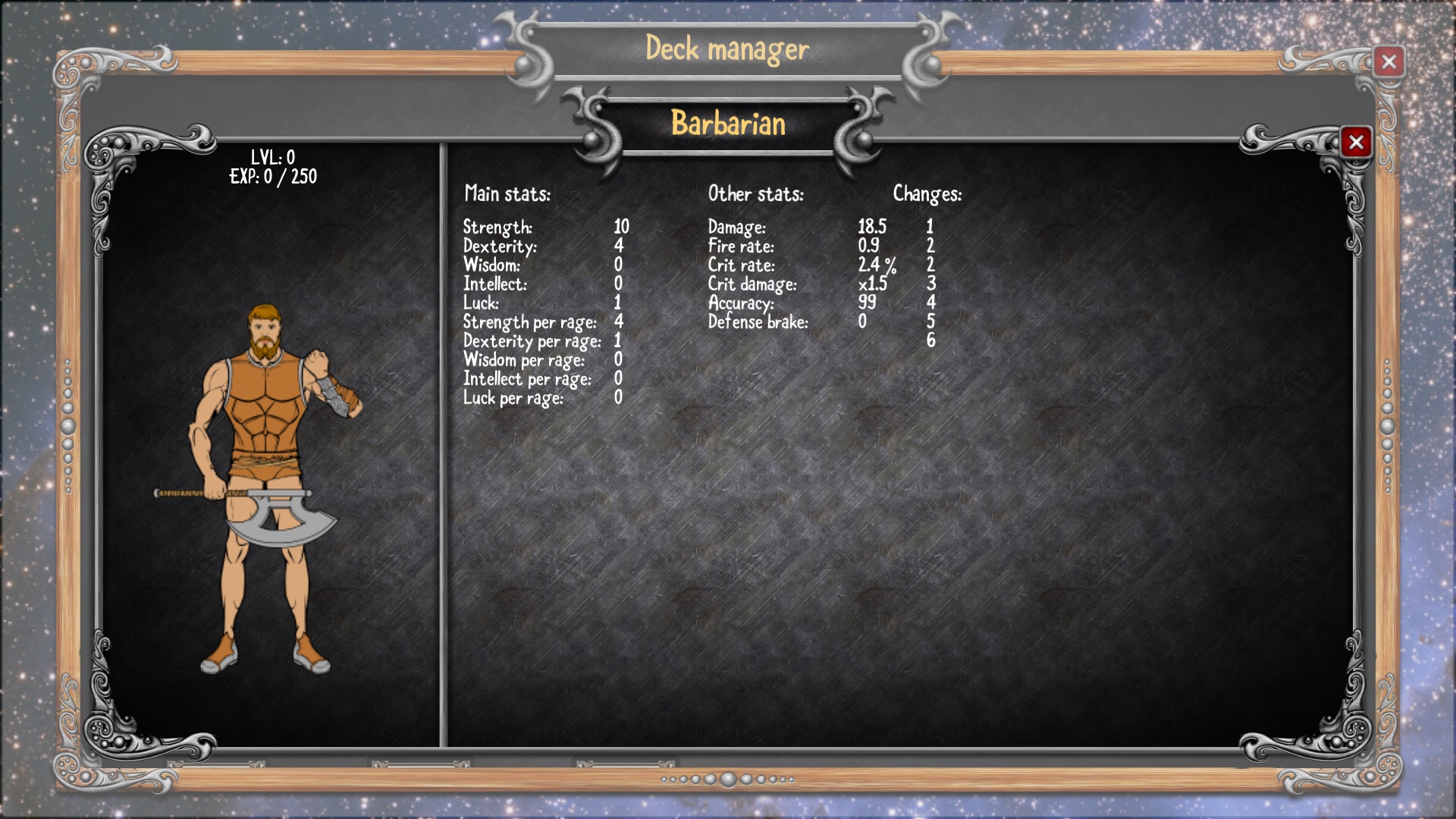
Gradually, the game began to acquire functions that I have not seen in other games, as well as interesting mechanics. Most of the questions were to visual execution. But since the game was made “for myself” - this did not cause any problems.
I did not pay a penny to the designer, I took pictures and music from open free sources. For example, to create heroes, I used the free program Hero Machine, for tiles of maps I drew something myself, for music - YouTube. In general, for 2-3 months of development (as it seemed to me the training of Unity), I did not even think about sales, or so on.
If the free program for creating heroes-defenders helped me, I could not create decent enemies. At some point I wanted to make different types of enemies and at the same time looking good. My eyes fell on the freelance exchange. I placed an order to create a 2D wolf and its sprite animation on one of the exchanges (something like freelance.com). There were many answers, of course I chose the most budget option. The first wolf cost me $ 20.
After I integrated the wolf into the game and saw how much the game looks better - I thought about more enemies. I looked for the guys on the domestic freelance exchanges and found there a person who requested less overseas artist, and I liked his style more.
He drew me new enemies “wolf”, “boar”, “ent” for the first act of the game. They looked cooler than all my game graphics, so I ordered a new UI from it. All the work of the designer (drawing the first act + UI) cost about $ 200.
I began to see the game take on some real shape. Added a forge and shop, the designer began work on the second act (undead). The designer drew the enemies themselves, as well as maps - levels. The second act cost me $ 100-150.
I started thinking about the Steam Greenlight to get at least some feedback.
I saw an announcement about participation in the “Game Planet” festival. They asked for 5000 rub. For participation. They gave a 1m x 2m booth. I was interested, so I agreed. I took a colleague from the job as an assistant (thanks to him for his help), printed a bunch of waste paper (thanks to a free printer at work), prizes, banners, t-shirts, bought chocolates. In general, two days of the festival cost me about $ 150-200.
Also, by the start of the festival, I designed a page on Steam to launch the game on Greenlight. It seemed to me that it would be possible to draw attention to the game at the festival and quickly qualify on Steam.

There were 8 booths in the indie venue at the festival. It seems to me not very lucky with the location. On my right, there was a game about racing (represented by the PUBLISHER, developers in Ukraine), on the left, the game “Mushrooms Wars 2” (the guys themselves said that Apple helped them with the design). Why these guys considered themselves indie and why the organizers also thought was not clear to me. In general, against their background, I (and the rest of the real indie developers) looked worse. I showed the game on a PC as well as on a cheap tablet with Windows.

We showed our game, collected opinions, asked to vote on Steam, distributed certificates for the free Steam version, etc. They also tried to attract people to our groups in social networks (they promised additional rallies, prizes and news there).

It was interesting to watch the players, that they understand what caused the difficulties. Players found bugs and spoke their opinions. Most complaints were on the schedule. It was too simple and it was silly to argue with that. The graphics could not look like old school or pixel. She was just bad (because I did most of it myself). The mechanics of the game people liked and was interesting to them. It is also surprising, but the children liked the game (up to 10 years old). It seems that they saw the TD genre for the first time, and he was very fascinated by them. One mother left us a child for several hours (both days of the festival), and he sat in the corner of the booth and played.
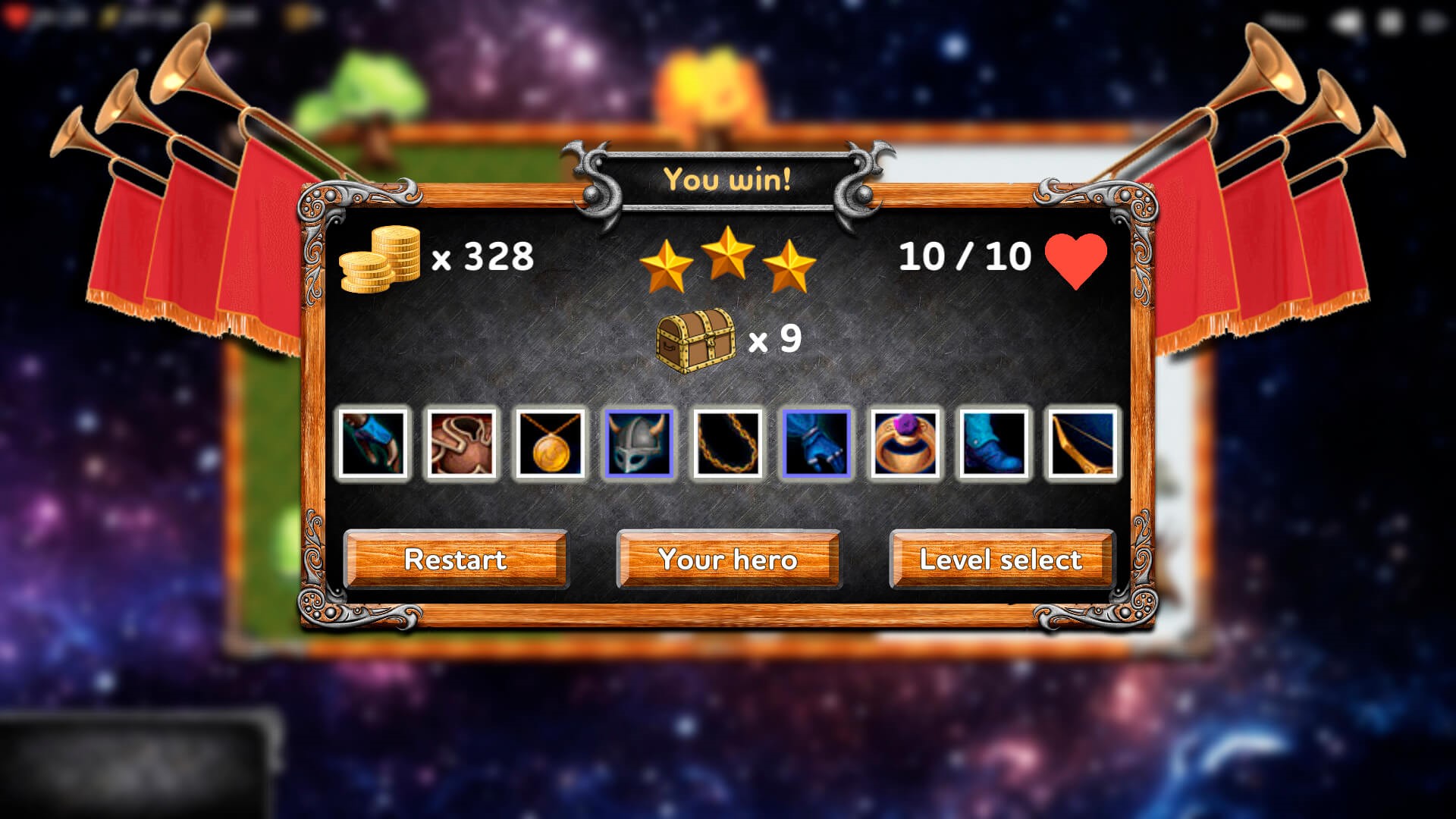
I also met a few cool guys (also indie developers) and I had people with whom I could discuss my creation, get professional opinion, advice.
In the end, I can say that all the benefits of the festival are a few voices on Steam, the understanding that you need to change the schedule, a few new acquaintances.
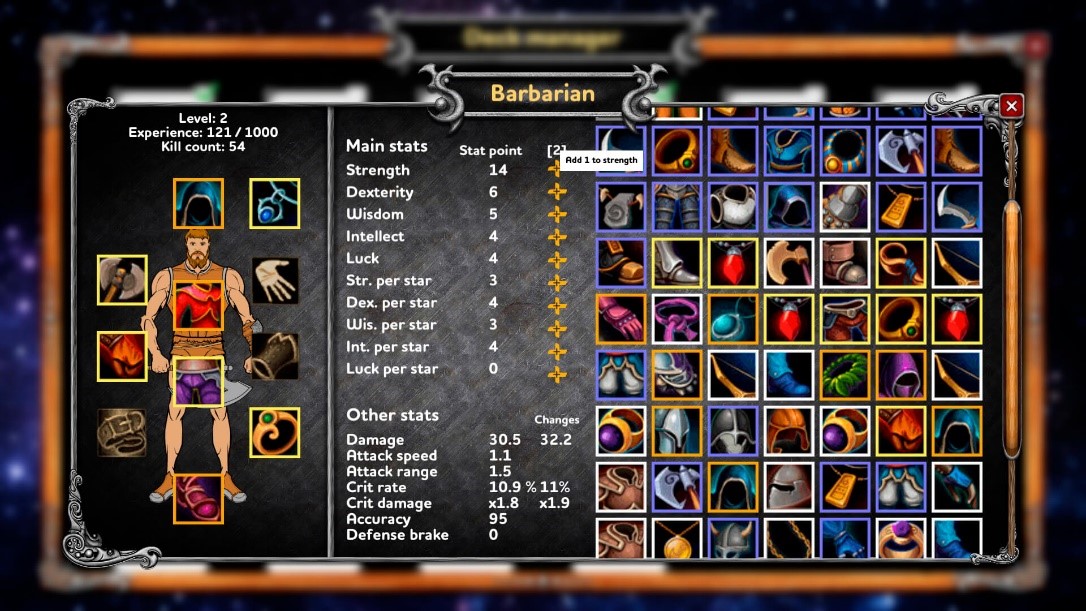
Writing how to pass Steam Greenlight does not make much sense, because he will be no more. But it all came down to the fact that it is necessary to catch up with “prepared traffic”. Otherwise, your game is not needed by anyone and the standard comment will be “what the next shit !?”.
I also tried a crowdfunding company in the Russian service Boomstarter. For me it has become a waste of time. The service does not have its own traffic, and if you do not have hundreds of people who want to invest in you - you will not find new ones there.
Passing Steam Greenlight is awesome. This means that the hours spent on development, money on graphics, $ 100 for the participation itself - it was all in vain. To someone (besides you) your game is interesting, and he is theoretically ready to buy it.
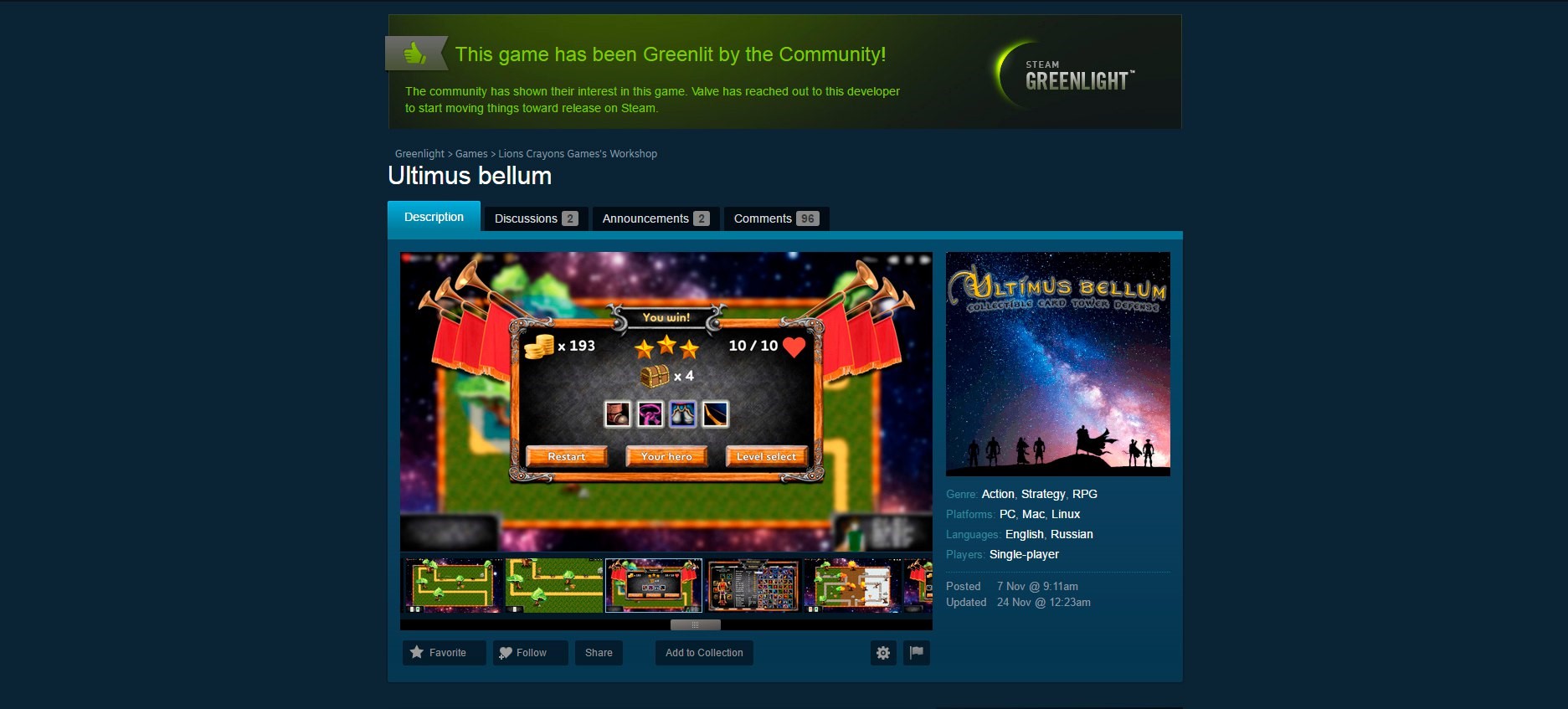
Steam Greenlight left a dual impression. First, it turned out to pass it in just 2 weeks. It is fast and good, and it should be proud of it. But secondly, I realized that without “prepared traffic” it would not have been possible to go so quickly (it would have been possible to hang for a few months or six months). I also read a lot of comments like “game - g *** o”, “author * Roskomnadzor * against the wall”, etc. I, as unprepared for this, was unpleasant. I called the game on the same Greenlight like it if I like it. If I didn’t like someone else’s game, I just passed by.
Next was the new year, then I was invited to an interesting freelancing project. I ordered my designer to redraw maps (levels), because the existing ones absolutely did not fit. Development stopped at about half a year.

New levels have become prettier, I began to add particles for beauty (particles). There was also the process of bugfixing and adding what was offered by players from the festival.
Several times I went to the Petersburg game-party parties, chatted, drank beer. The correct idea was expressed by Oleg Pridiuk: “games must be done not in order to do, but in order to sell”. This thought became close to me, because up to this point, I did not particularly think about selling. I liked the development process itself - to set a goal, to implement, to invent a new mechanic - to do it.

In the meantime, I found another designer. The first one had other projects (maybe more cash, maybe more interesting).
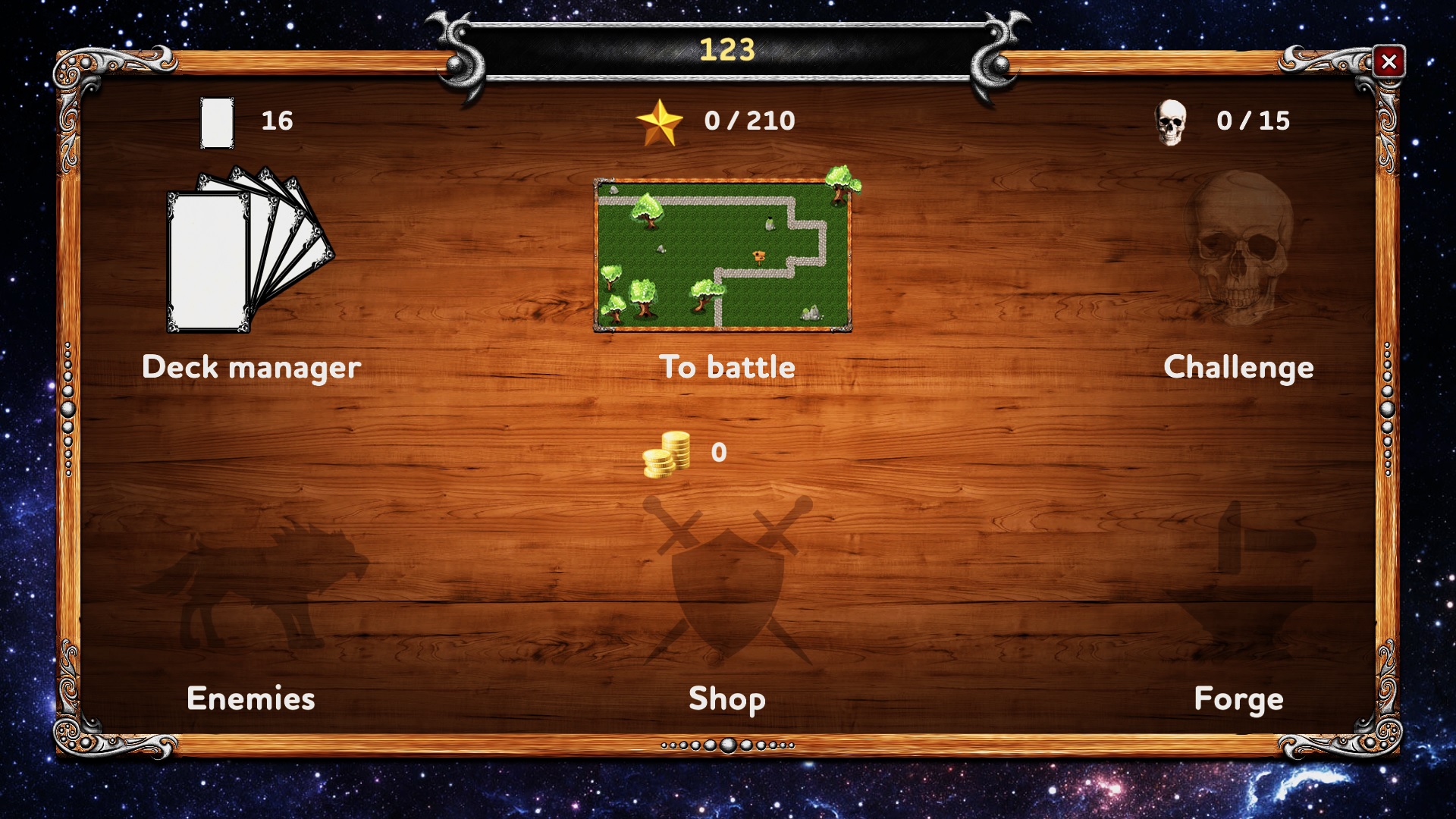
With the second designer, we started by redrawing the main menu of the game (picture above). This is the first (after the splash screen) that the player sees and in my opinion it should have been cool. I really liked what turned out:
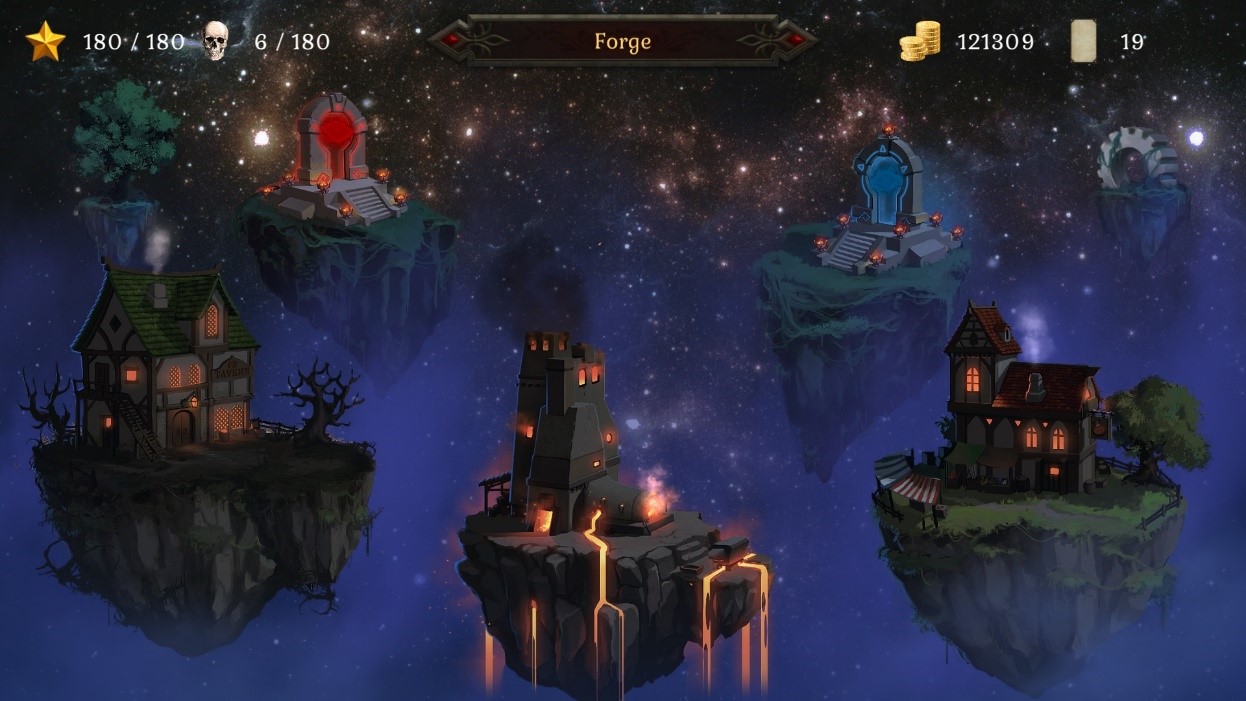
This picture cost me about $ 40 but made the first impression about the game better. We continued to work and decided to start by redrawing the UI. Old wooden UI looked bad with new elements.
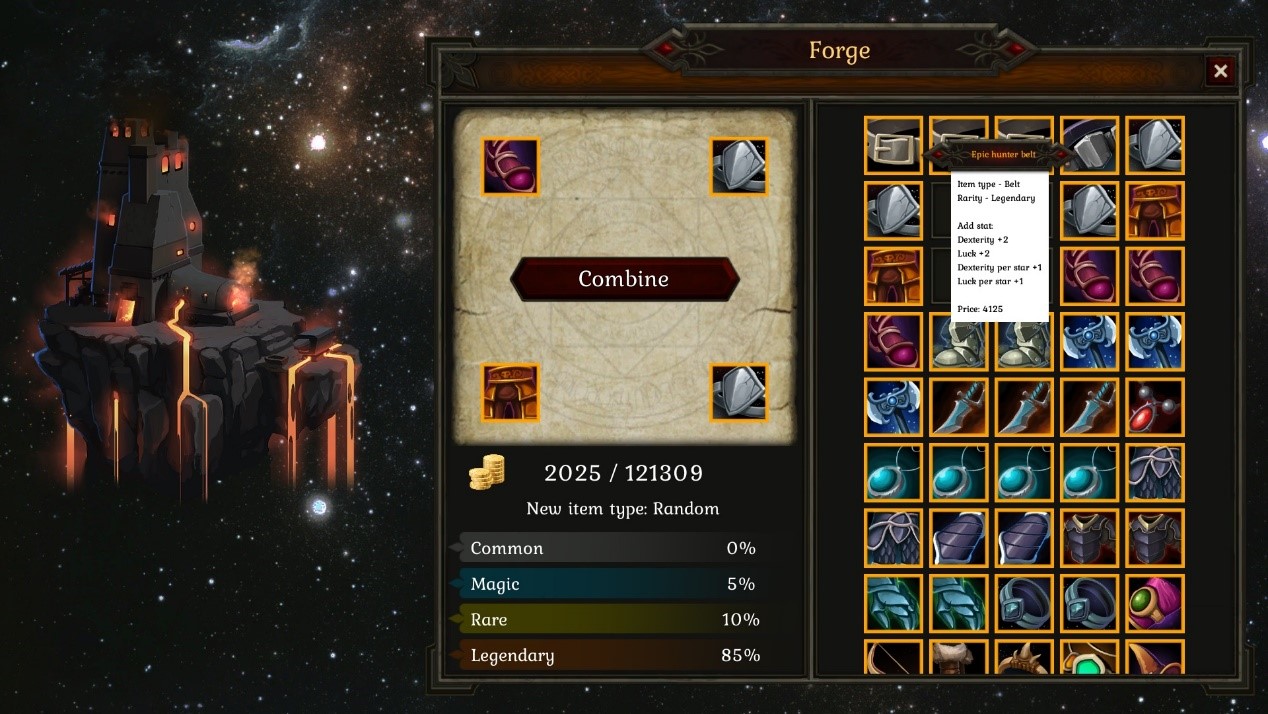
The new UI cost me $ 100, and since the first designer was not released - it was decided that the second designer would take care of all the new tasks. We have drawn the second act, the interfaces, he made some comments on the color-font. I planned to exit on Wednesday, November 8th. By the way, you can change the release date at least every day. The game will then hang in the lists "coming out soon," and before its release will have time to attract some attention. I did not use such tactics, but they say it works.
The game in this form was ready (in my opinion) to exit on Steam Early Access. To the surprise of the preparation took a lot of time (from the finished build to the release of Steam). Starting from the addition of the Steam SDK and ending with the hundreds of pictures that Steam needs for your game, also loading the first build is not clear (thanks to the one who helped to figure it out). It is also necessary to fill in any tax information, create a description of the game and a description of early access (I did in Russian and English), achievements, maps, emoticons, etc. I think the preparation process took me about a week.
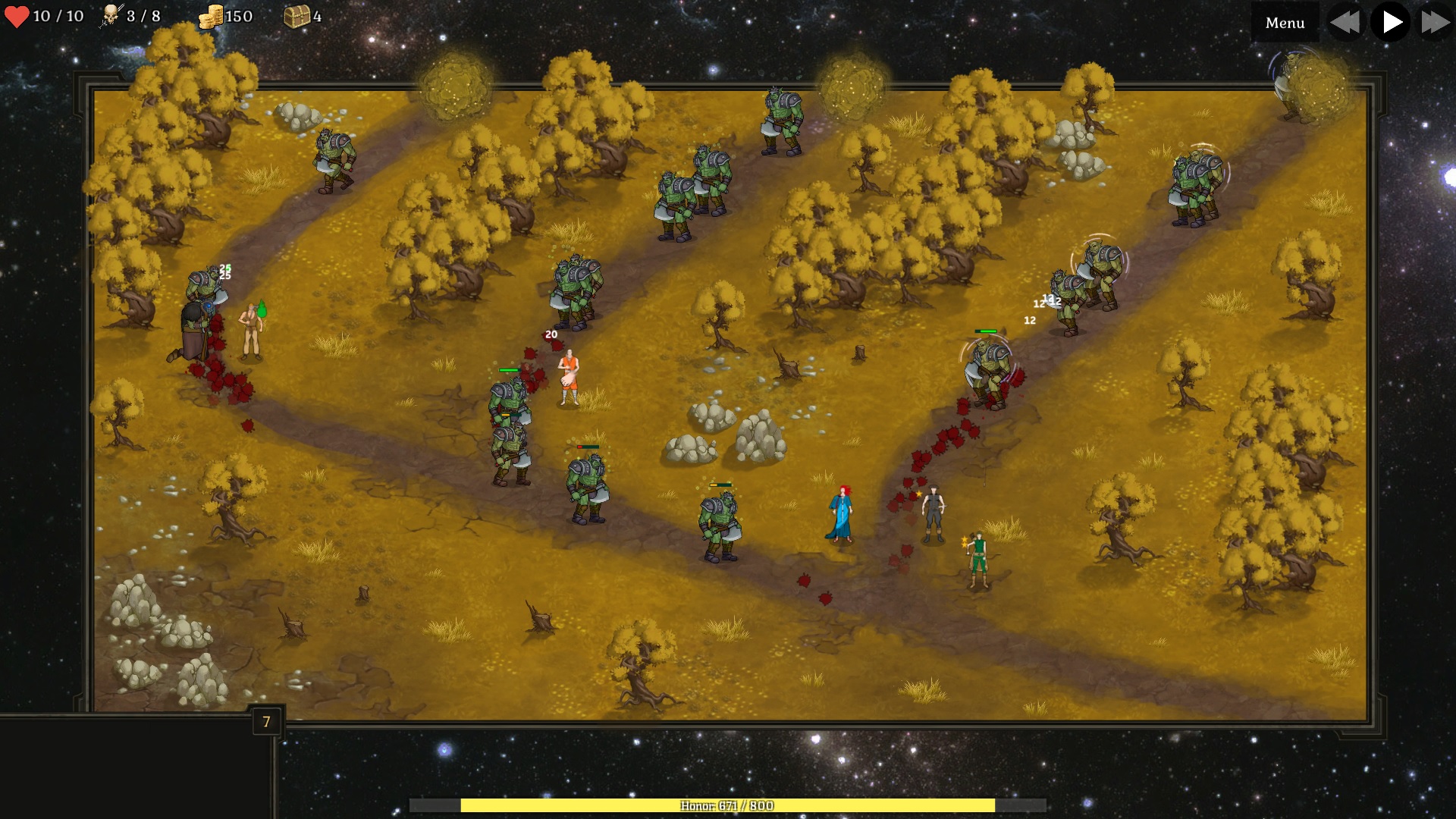
I also tried to lead groups in social networks, the old man on IndieDB, etc. All this takes a LOT of time, and instead of making the game - I made pictures in Photoshop. In general, if you have a person who can take on this work (or you are at least one in the team), then you are lucky.
Also for me it was not easy to decide on the price and the day of the week / date for the release of the game. I read a few articles, and that's what I understood for myself:
Total - Early Access is very cool. Players are more loyal to bugs, you get a bunch of testers (who also pay you for the game), their opinions, suggestions. At the time of this writing, the game has been sold 110 times (a month since the start of Early Access). But about 80 purchases were made in the first week, while there was a 10% discount. Also, the game was added to the “Wishlist” 760 times. I hope these people are waiting for release / good discounts. I have not received money from Steam yet, because Payments occur at the end of the month, for the last month. As I understood from the articles - first Steam pays all sales taxes, and then takes 30% of the revenue. As a result, 40-50% of the amount of all sales can come out. I also do not have statistics on sales of collection cards (Steam also gives% of their sales), but I don’t expect anything special there.

By the time the game is released, I will have all the bugs fixed and everything the community wants added. Also, I will have a certain number of reviews (as long as it is kept in the status of “positive”). So I don’t see a single minus in Early Access - it’s cool and works.
What I tried and what I got:
Total: 59 800 rubles. or about $ 1000.
I can already see that the game will completely discourage all investments, and even bring some kind of income. Of course, I could not live on this money, but a hobby that brings a small income is cool. I also want to try to get on iOS and Android on readiness (this will bring another interesting experience). The game has to play on the tablet.
Will I make more games? Definitely yes!
PS: if someone wants to play, but for some reason you don’t want to buy - write, share the key for free (the number of keys is limited).

Unity introduction
Since One of my favorite genres is TD (tower defense, tower defense) - I wanted to try to create something similar to a game of this genre. Before I started working with Unity (and accordingly with C #), I only worked with PHP and Python.
A bunch of Unity + C # seemed to me more successful (and simpler) than the Unreal Engine + C ++. To begin with, I met C # (I made a simple program in Visual Studio), and then I started learning Unity. If you already own a good level of one of the programming languages - C # will be simple and straightforward. Getting to know Unity is much more difficult.
')
Unfortunately, at the time of the beginning of the creation of the game I did not read more than one book on Unity. I started with several online courses and videos that fluently introduce Unity tools. I can call it one of the biggest mistakes. That is, I studied working with Unity directly working in Unity (creating the game). But in principle, this did not contradict what I wanted. At the very beginning I did not think that the game would turn out, and I would start selling it. I just wanted to get acquainted with the engine, maybe after that try the UE.
The first steps
After watching a few videos, as well as an excellent video tutorial on creating TD in Unity, I started my own business. I had only a few hours a week to create a game. I watched the video, read the documentation, googled incomprehensible moments, did something. The game began to turn from “circles shooting squares” into “a man with an ax beats a wolf”. I slowly mastered the simplest tools of Unity and interaction with C #. Unfortunately, the very first versions of the game, or screenshots, have not been preserved (those that are, this is about 2-3 months from the start of creation).

According to my estimations, that small squares began to run on the map, and circles would be shooting at them — it took about two weeks. On the fact that to replace the squares on the enemies, and the circles on the defenders and also the levels on something similar to TD - a few more weeks.

I also made the simplest menu, and something like a deck manager, because I have a TD with elements of CCG (collectible card games) and RPG. Then work began on the RPG component, it was interesting for me to come up with formulas for calculating damage, armor, accuracy, crit, etc. and add to all this CCG.

Gradually, the game began to acquire functions that I have not seen in other games, as well as interesting mechanics. Most of the questions were to visual execution. But since the game was made “for myself” - this did not cause any problems.
I did not pay a penny to the designer, I took pictures and music from open free sources. For example, to create heroes, I used the free program Hero Machine, for tiles of maps I drew something myself, for music - YouTube. In general, for 2-3 months of development (as it seemed to me the training of Unity), I did not even think about sales, or so on.
First spending
If the free program for creating heroes-defenders helped me, I could not create decent enemies. At some point I wanted to make different types of enemies and at the same time looking good. My eyes fell on the freelance exchange. I placed an order to create a 2D wolf and its sprite animation on one of the exchanges (something like freelance.com). There were many answers, of course I chose the most budget option. The first wolf cost me $ 20.
After I integrated the wolf into the game and saw how much the game looks better - I thought about more enemies. I looked for the guys on the domestic freelance exchanges and found there a person who requested less overseas artist, and I liked his style more.
He drew me new enemies “wolf”, “boar”, “ent” for the first act of the game. They looked cooler than all my game graphics, so I ordered a new UI from it. All the work of the designer (drawing the first act + UI) cost about $ 200.
I began to see the game take on some real shape. Added a forge and shop, the designer began work on the second act (undead). The designer drew the enemies themselves, as well as maps - levels. The second act cost me $ 100-150.
I started thinking about the Steam Greenlight to get at least some feedback.
Game Planet 2016
I saw an announcement about participation in the “Game Planet” festival. They asked for 5000 rub. For participation. They gave a 1m x 2m booth. I was interested, so I agreed. I took a colleague from the job as an assistant (thanks to him for his help), printed a bunch of waste paper (thanks to a free printer at work), prizes, banners, t-shirts, bought chocolates. In general, two days of the festival cost me about $ 150-200.
Also, by the start of the festival, I designed a page on Steam to launch the game on Greenlight. It seemed to me that it would be possible to draw attention to the game at the festival and quickly qualify on Steam.

There were 8 booths in the indie venue at the festival. It seems to me not very lucky with the location. On my right, there was a game about racing (represented by the PUBLISHER, developers in Ukraine), on the left, the game “Mushrooms Wars 2” (the guys themselves said that Apple helped them with the design). Why these guys considered themselves indie and why the organizers also thought was not clear to me. In general, against their background, I (and the rest of the real indie developers) looked worse. I showed the game on a PC as well as on a cheap tablet with Windows.

We showed our game, collected opinions, asked to vote on Steam, distributed certificates for the free Steam version, etc. They also tried to attract people to our groups in social networks (they promised additional rallies, prizes and news there).

It was interesting to watch the players, that they understand what caused the difficulties. Players found bugs and spoke their opinions. Most complaints were on the schedule. It was too simple and it was silly to argue with that. The graphics could not look like old school or pixel. She was just bad (because I did most of it myself). The mechanics of the game people liked and was interesting to them. It is also surprising, but the children liked the game (up to 10 years old). It seems that they saw the TD genre for the first time, and he was very fascinated by them. One mother left us a child for several hours (both days of the festival), and he sat in the corner of the booth and played.

I also met a few cool guys (also indie developers) and I had people with whom I could discuss my creation, get professional opinion, advice.
In the end, I can say that all the benefits of the festival are a few voices on Steam, the understanding that you need to change the schedule, a few new acquaintances.

Writing how to pass Steam Greenlight does not make much sense, because he will be no more. But it all came down to the fact that it is necessary to catch up with “prepared traffic”. Otherwise, your game is not needed by anyone and the standard comment will be “what the next shit !?”.
Boomstarter
I also tried a crowdfunding company in the Russian service Boomstarter. For me it has become a waste of time. The service does not have its own traffic, and if you do not have hundreds of people who want to invest in you - you will not find new ones there.
Life after greenlight
Passing Steam Greenlight is awesome. This means that the hours spent on development, money on graphics, $ 100 for the participation itself - it was all in vain. To someone (besides you) your game is interesting, and he is theoretically ready to buy it.

Steam Greenlight left a dual impression. First, it turned out to pass it in just 2 weeks. It is fast and good, and it should be proud of it. But secondly, I realized that without “prepared traffic” it would not have been possible to go so quickly (it would have been possible to hang for a few months or six months). I also read a lot of comments like “game - g *** o”, “author * Roskomnadzor * against the wall”, etc. I, as unprepared for this, was unpleasant. I called the game on the same Greenlight like it if I like it. If I didn’t like someone else’s game, I just passed by.
Next was the new year, then I was invited to an interesting freelancing project. I ordered my designer to redraw maps (levels), because the existing ones absolutely did not fit. Development stopped at about half a year.

New levels have become prettier, I began to add particles for beauty (particles). There was also the process of bugfixing and adding what was offered by players from the festival.
Several times I went to the Petersburg game-party parties, chatted, drank beer. The correct idea was expressed by Oleg Pridiuk: “games must be done not in order to do, but in order to sell”. This thought became close to me, because up to this point, I did not particularly think about selling. I liked the development process itself - to set a goal, to implement, to invent a new mechanic - to do it.

In the meantime, I found another designer. The first one had other projects (maybe more cash, maybe more interesting).

With the second designer, we started by redrawing the main menu of the game (picture above). This is the first (after the splash screen) that the player sees and in my opinion it should have been cool. I really liked what turned out:

This picture cost me about $ 40 but made the first impression about the game better. We continued to work and decided to start by redrawing the UI. Old wooden UI looked bad with new elements.

The new UI cost me $ 100, and since the first designer was not released - it was decided that the second designer would take care of all the new tasks. We have drawn the second act, the interfaces, he made some comments on the color-font. I planned to exit on Wednesday, November 8th. By the way, you can change the release date at least every day. The game will then hang in the lists "coming out soon," and before its release will have time to attract some attention. I did not use such tactics, but they say it works.
Steam early access
The game in this form was ready (in my opinion) to exit on Steam Early Access. To the surprise of the preparation took a lot of time (from the finished build to the release of Steam). Starting from the addition of the Steam SDK and ending with the hundreds of pictures that Steam needs for your game, also loading the first build is not clear (thanks to the one who helped to figure it out). It is also necessary to fill in any tax information, create a description of the game and a description of early access (I did in Russian and English), achievements, maps, emoticons, etc. I think the preparation process took me about a week.

I also tried to lead groups in social networks, the old man on IndieDB, etc. All this takes a LOT of time, and instead of making the game - I made pictures in Photoshop. In general, if you have a person who can take on this work (or you are at least one in the team), then you are lucky.
Also for me it was not easy to decide on the price and the day of the week / date for the release of the game. I read a few articles, and that's what I understood for myself:
- You can not release the game during sales, as well as a week before and after.
- The best day for release is Wednesday - Thursday - Friday. If your game falls to the top, then it will hang there all weekend.
- VR games are very popular now. They clog the entire top.
- Do not underestimate your game. As a result, I set the price of $ 9.99 (259 rubles in Russia). Steam has its own prices for each country. I think the price is right, if I chose the price of $ 4.99 - I don’t think I would get 2 times more sales. Although I can not check it out. As written in one of the articles - you know better how much your game costs.
- The discount in honor of the release is good. I put 10%. While there was a discount - the game was sold (approximately 10-15 sales per day). When the discount ended sales immediately fell to 1-2 per day.
- Because of the policy of Steam (you can not make discounts very often), I missed the fall sale. On the winter, I already get. So, choosing the release date of the game - you can think about it.
Total - Early Access is very cool. Players are more loyal to bugs, you get a bunch of testers (who also pay you for the game), their opinions, suggestions. At the time of this writing, the game has been sold 110 times (a month since the start of Early Access). But about 80 purchases were made in the first week, while there was a 10% discount. Also, the game was added to the “Wishlist” 760 times. I hope these people are waiting for release / good discounts. I have not received money from Steam yet, because Payments occur at the end of the month, for the last month. As I understood from the articles - first Steam pays all sales taxes, and then takes 30% of the revenue. As a result, 40-50% of the amount of all sales can come out. I also do not have statistics on sales of collection cards (Steam also gives% of their sales), but I don’t expect anything special there.

By the time the game is released, I will have all the bugs fixed and everything the community wants added. Also, I will have a certain number of reviews (as long as it is kept in the status of “positive”). So I don’t see a single minus in Early Access - it’s cool and works.
Ways to increase sales
What I tried and what I got:
- Posts in VK (in groups with the theme of the game \ indie games). The most expensive cost several thousand rubles (Igromania), the cheapest - for free. Also played a few dozen keys.
Bottom line: Russia is in second place in sales on Steam - about 20% in revenue and 45% in terms of sales. For example, the United States 27% of revenue and 10% of the number of sales. - IndieDB. He wrote the news - played the keys.
Bottom line: difficult to estimate, but several people a day come to the Steam page with IndieDB. If you have someone to do this - you need to do. - keymailer.co. An interesting service - you distribute free keys to the game, to all kinds of reviewers and vlogers. In theory, they should play and post reviews on YouTube, Twitch, Twitter, etc.
Bottom line: for 200-250 keys handed out, 25 people played the game, only 2 did a normal review, some simply trashed the trailer, the rest did not give the result. Maybe after the release will be more confusing. - Festivals. I participated only in 1 and at that time the game could not be bought, but it ended up paying for distributing a bunch of keys. The sense of the festival - new game-girl dating, but it was possible to meet in another place.
- Bandla. Almost on the first day they sent me a proposal to participate in a big bandle. Approximately $ 600-2000 of income was annoying, but at the moment I have refused. Bundles will not go anywhere, they should be used when the game is not for sale at all.
- Coupons. You can set up Steam for players to drop coupons with a big discount on your game. I tried (30% and 60% discount), but only 5 people bought coupons, so I didn’t see much sense. Maybe a 90% discount will buy more, but so far I do not see the point.
- Other I also received suggestions from some individuals to give them keys, someone gave, someone sent, the result is not clear. They also write all kinds of “curators” from Steam, who are ready to write something for a coin. I did not use these.
Total budget
- Zero designer - $ 20. I painted a wolf, which the designer 1 then redrawn.
- First designer - 16600 rubles. Includes 12 cards - levels (first 2 acts), monsters - wolf, wild boar, ent, zombie, skeleton. Ui which was then redone. Movie for Steam Greenlight.
- Second designer - 23,000 rubles. Enter the picture - the menu. Alteration of the entire UI. 12 levels (3-4 act). Monsters - Banshee, Orc, Goblin, Shaman Orc, as well as monsters-demons for the act 4.
- Festival GamePlanet 2016 - 10,000 rubles. Participation (5000r), prizes, chocolates, t-shirts, etc.
- Advertising - 6000 rub. Posts in several domestic groups in the VC and something else.
- Participation in the Steam Greenlight - $ 100 (for Russia 3000 rubles.).
- My work is priceless. I can only roughly estimate how much time I spent. I think something in the region of 300-500 hours. Estimating money is useless, I take the development of the game as a hobby.
Total: 59 800 rubles. or about $ 1000.
I can already see that the game will completely discourage all investments, and even bring some kind of income. Of course, I could not live on this money, but a hobby that brings a small income is cool. I also want to try to get on iOS and Android on readiness (this will bring another interesting experience). The game has to play on the tablet.
Will I make more games? Definitely yes!
PS: if someone wants to play, but for some reason you don’t want to buy - write, share the key for free (the number of keys is limited).
Source: https://habr.com/ru/post/344350/
All Articles